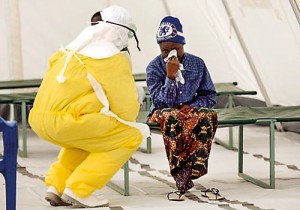Sunday Times 2
Compound from Chinese medicinal herb shows promise for Ebola
View(s):WASHINGTON (Reuters) – A drug derived from a Chinese medicinal herb is showing promise for combating Ebola infection, effectively imprisoning the virus inside cells so it cannot do its usual damage, scientists said on Thursday.

A health worker wearing protective gear tends to a newly admitted suspected Ebola patient in a quarantine zone at a Red Cross facility in the town of Koidu, Kono district in Eastern Sierra Leone in this 2014 file photo (Reuters)
The researchers said the compound, called tetrandrine, blocked infection of human white blood cells in lab dishes and prevented Ebola virus disease in lab mice. More research is needed, including monkey studies, before it can be tested in people, they added.
“The work has revealed a new chink in the armor of Ebola virus,” said virologist Robert Davey of the Texas Biomedical Research Institute in San Antonio, who estimated this approach potentially could be used to treat people in two to five years.
“I am hopeful that the dose needed to control disease will be safe but we just have to do the work and find out,” Davey added.
There is no approved drug treatment or vaccine for the Ebola virus, which causes hemorrhagic fever and spreads person to person through contact with body fluids.
“In my opinion, tetrandrine is now one of the most promising candidates that could be used to inhibit Ebola virus infection,” said Norbert Klugbauer, a pharmacologist and microbiologist at Germany’s University of Freiburg who also worked on the study published in the journal Science.
To successfully infect a cell, the virus needs to be transported deep within it in order to break out of bubble-like intracellular transport structures called endosomes that carry the virus within the cell.
The researchers identified channels that are important in controlling the movement of the “bubbles” within cells. These are known as “two-pore channels.” The study showed that tetrandrine blocked these channels, effectively imprisoning the virus inside the “bubbles” so it could not actually infect the cell.
“The virus is then trapped in the bubble and cannot escape. It is then detoured to be destroyed. This stops infection,” Davey said.
In human cells in lab dishes, the researchers found tetrandrine inhibited infection by the virus of white blood cells called macrophages. These cells are important players in the immune system’s ability to ward off foreign invaders like viruses and bacteria, basically swallowing them up.
Tetrandrine is derived from the root of a medicinal herb, Stephania tetrandra. It also lowers blood pressure.
More than 9,500 deaths have been reported in three West African countries since the world’s worst Ebola outbreak began in December 2013.

